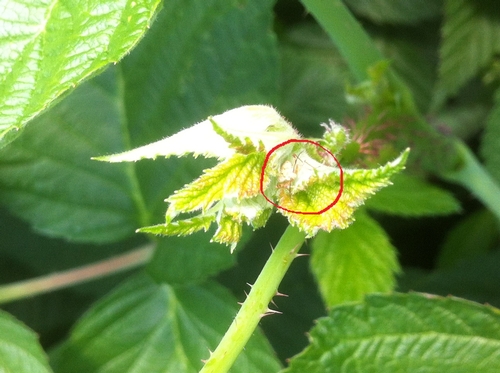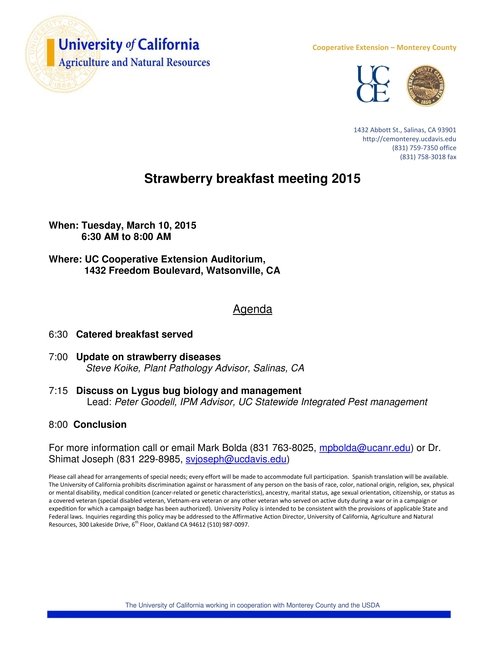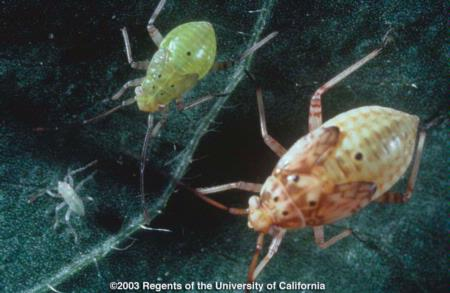
- Author: Mark Bolda
A couple of pictures below from a farm call concerning unusual damage on the tips of growing raspberry. Some of the leaves are affected as in Photo #1, but others are pretty well aborted and not growing at all. Incidence wasn't more than 5%, but still this is disconcerting and I was over at the grower field within 15 minutes to take stock of the situation. No flowers or fruit yet on the plants.
No signs of frass or webbing that would be associated with leafrollers (some like to feed at the nitrogen rich tips), and I've checked this sort of thing in caneberries before and haven't found that viruses or nutrients are at cause either.
But we did find lygus and Photo #2 explains that we may have identified the cause. While some lygus were to be found wandering around on leaves, others were nestled in the growing point of the plant, which on the very young leaf can show up as a lot of damage later on when it fully expands. It's quite possible that this insect activity could be causing the tip to die entirely in a situation reminiscent of "black flagging" in cotton, which is the death of terminals in cotton caused by lygus feeding.



- Author: Mark Bolda
So that growers, PCA's and other agricultural people might have a bit more access to UC and UCCE scientists, entomology Advisor Shimat Joseph is sponsoring a breakfast meeting at my auditorium at 1432 Freedom Blvd in Watsonville on March 10. We have both Plant Pathology Farm Advisor Steven Koike speaking about diseases, followed by our special guest entomologist and IPM Advisor Pete Goodell out of the Kearney research station in the Central Valley (he has a enormous amount of experience with lygus).
Point is to have a good discussion between people involved in strawberry production and UC scientists, along with having a great breakfast of course. Come by if you have the time - starts at 630 am and will be wrapped up by 8.

- Author: Mark Bolda
The lygus meeting planned for tomorrow, March 27 at the end of Jensen Road in Moss Landing will now be held at the UC Cooperative Extension office at 1432 Freedom Blvd in Watsonville.
See you there!
- Author: Thomas Flewell
I saw this photo in the UC IPM archives. Since it is a really unusual configuration and the fact that lately bug-vacs have become a bigger part of the lygus management discussion again, I thought this might be something to share with my readers.
To find out more, I contacted Thom Flewell, who wrote this in response:
"I used to have 3 bug vacs with that general configuration. The fans were from plastics manufacturing and were used to move the pellets that formed the feed stock for producing plastics. Mike McCluney made many Bug Vacs using these fans, usually with one fan per bed. They were very heavy, and demanded about 17 horse power per fan. The tractors had barely enough power to operate the fans and move the machinery down the rows. There were two disadvantages with these machines. The size of the fans required mounting them off the back of the tractor. The aspirator head had to be placed forward of the tractor to keep from scaring the lygus and causing them to drop below the effective suction zone of the machine. The problem was with the distance that separated the head and the fan. Vacuum was reduced significantly along the travel from the head to the fan. The second problem was the weight of the machines. It was not uncommon to have a driver let his attention wander and the tractor then wandered too, going from the hard-packed furrow to the soft and soggy bed. When the wheels left the furrow and sunk in the beds, destruction followed and pulling the tractor back up onto the furrow was like trying to pull it from a swamp onto a railroad track.
The greatest advantage to these fans was that nothing that enter the volute exited alive. The fan employed flat impeller blades accounting for their inefficiency. But that same inefficiency meant that air and anything entrained in the air flow probably collided either with the blades or the side of the fan before exiting. Only parts remained. "
Thanks Thom!

- Author: Mark Bolda
UCCE is sponsoring a meeting on lygus in strawberries to be held April 18. Four Ph.D. level entomologists (and one fruit guy) will bring together a veritable brain trust in one room to share decades of experience and knowledge in entomology and lygus bugs.
Biology, sampling, cultural, chemical and biological control of lygus will all be discussed. This is without a doubt a can't miss event for growers, PCA's and anyone else interested in the latest and most in-depth information available on this difficult pest.
Agenda is to be found here:


